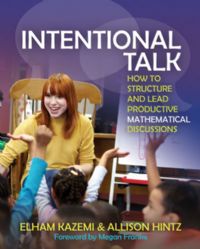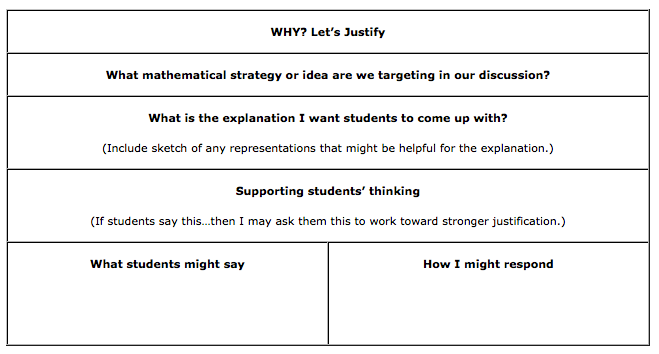Successful Intentional Talk in Mathematics Class
Intentional Talk: How to Structure and Lead Productive Mathematical Discussions
By Elham Kazemi and Allison Hintz
(Stenhouse Publishers, 2014 – Learn more)

Research studies tell us that student interaction, through classroom discussions and other types of interactive participation, leads to deeper understanding and student achievement. The Common Core Anchor Standards for Speaking and Listening note that “students must have ample opportunities to take part in a variety of rich, structured conversations—as part of a whole class, in small groups, and with a partner.” And:
“Being productive members of these conversations requires that students contribute accurate, relevant information; respond to and develop what others have said; make comparisons and contrasts; and analyze and synthesize a multitude of ideas in various domains.”

Elhmam Kazemi and Allison Hintz, co-authors of Intentional Talk: How to Structure and Lead Productive Mathematical Discussions, give us a glimpse into classrooms where intentional talk is encouraged and modeled. They also give the reader an insight into how to meet the “what ifs” seamlessly.
More about the book
Intentional Talk is guided by four principles (p.2):
- Discussion should achieve a mathematical goal, and different types of goals require planning and leading discussions differently.
- Students need to know what and how to share so their ideas are heard and are useful to others.
- Teachers need to orient students to one another and the mathematical ideas so that every member of the class is involved in achieving the mathematical goal.
- Teachers must communicate that all children are sense makers and that their ideas are valued.
Ms. Kazemi and Ms. Hintz carefully organized this book around short yet detailed vignettes gathered from lower and upper elementary school classrooms. Each chapter is structured to provide a bird’s eye view of five targeted discussion models from the perspective of several grade levels:
- Compare and Connect
- Why? Let’s Justify?
- What’s the Best and Why?
- Define and Clarify
- Troubleshoot and Revise
Listening in to intentional talk
One of my goals is to create a classroom culture of effective question-asking and deeper thinking, where the students are able to learn from shared discussion and feel confident and comfortable engaging in mathematical discussion. I was drawn to this book because I wanted to be able to “observe” other teachers as they applied intentional talk into their classrooms.
The anecdotal dialogues in each chapter allowed me to be an observer in several K-8 classrooms, as I read about a Master Teacher in action. This book is perfect for a teacher to use individually as a reflective learner or as part of a team or schoolwide professional learning community. At the end of each chapter the authors provide reflection questions and points to consider before reading on.
Chapter 4, “Why? Let’s Justify,” centers on helping the reader encourage students to daily apply mathematical reasoning. For me, it was one of those “Aha” moments. I know how important it is for children to use mathematical language, explain their thinking, listen to ideas of others and think critically each day. I know NCTM Standards emphasize the importance of developing mathematical language and communication in order to understand concepts, not merely following a sequence of procedures. What I was unsure of was how to encourage this type of thinking with automaticity.
As I read the conversations/vignettes “Why Do We ‘Append Zeroes’ When We Multiply by Multiples of Ten?” and “Fourth Graders Reason about Decomposing a Factor in Multiplication,” I was able to grasp the type of mathematical thinking my students needed to experience as well as to gather strategies that I could apply. For each discussion model, Karemi and Hintz provide planning templates, such as the example below, to assist the teacher as she or he strategizes the lessons.
The tools you need to build a culture of questioning
Intentional Talk is a book from the first page to the last that is sensitive to the needs of teachers and is based on deliberate research and feedback from teachers and students. Chapter 8 answers many of the questions that may arise in the reader’s mind. “Do I really have enough time for these types of discussions? What is my role as a teacher? How do students feel about participating in these discussions? How can I plan for open and targeted discussion?”
As you read Intentional Talk, you will be able to gain valuable insights into how to create a classroom culture of questioning and deeper thinking, in which pupils learn from shared discussion with the teacher and peers. Intentional dialogue directs students to focus their attention on becoming involved in mathematical thinking.
This book gives an unparalleled look at the importance that classroom discussions play in deepening students’ mathematical understanding. Intentional Talk supports the Common Core State Standards for Mathematics and includes an appendix with templates to help you quickly and easily apply strategies. If you want to engage your students to become more critical thinkers in math class, this book is an important must-read.
Linda Biondi is a fourth grade teacher at Pond Road Middle School in Robbinsville, NJ, and a recipient of several educational grants that infuse a literacy enriched curriculum with an understanding of individual learning styles to help students understand bias and patterns of discrimination. She is a Teacher Consultant with the National Writing Project and a participant on the NJ Department of Education Teacher Advisory Panel.






























I have definitely found that meaningful discussions and interactions can really enhance students’ understanding of math topics. I have recently started using a free math site called dimentor.com that not only integrates great real-world applications for all types of math, but it also has a built-in platform for interaction around math topics. Students can create their own challenges that incorporate math, solve those of others, earn badges, be part of a larger community of kids using math, and more.
There is also a premium version where students get personal mentoring and smart quizzes that explain the steps if students get stuck. Users get a free trial if they enter the code “dimentor2better”. Students really love creating these challenges and some good conversations happen in the comments.
Thanks for posting this great resource :)
Linda, Thanks so much for your positive review. Happy to learn from you about what you try with your students. Please share on twitter #intenttalk.